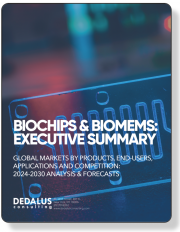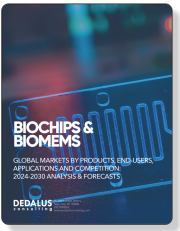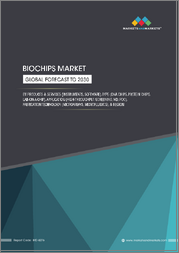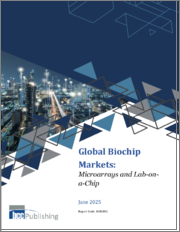
|
시장보고서
상품코드
1796849
바이오칩 시장 : 세계 산업 규모, 점유율, 동향, 기회, 예측 - 기술별, 유형별, 용도별, 최종사용자별, 지역별 부문, 경쟁(2020-2030년)Biochip Market - Global Industry Size, Share, Trends, Opportunity, and Forecast, Segmented By Technology, By Type, By Application, By End User, By Region and Competition, 2020-2030F |
||||||
세계의 바이오칩 시장은 2024년에 158억 2,000만 달러로 평가되었고, 2030년까지 연평균 복합 성장률(CAGR)은 14.46%로, 예측 기간에는 356억 5,000만 달러에 이를 것으로 예측됩니다.
바이오칩은 여러 생화학 반응을 동시에 수행하여 소요시간을 단축할 수 있도록 설계된 소형 의료기기입니다. 바이오칩은 고체 기판 위에 배치된 마이크로 테스트 사이트 또는 마이크로어레이로 구성됩니다. 바이오칩은 DNA, 단백질, 효소, 랩온칩 등 다양한 형태로 존재합니다. 이 작고 강력한 장치는 사용하기 쉽고, 정확하고 중요한 통찰력을 제공합니다. 특히 개인의 의료 정보 및 금융 정보 저장에 적합하며, 개인 추적에도 사용할 수 있습니다. 체내에 이식된 바이오칩은 환자의 건강 상태와 생물학적 과정을 모니터링, 분석, 제어할 수 있도록 돕습니다. 또한, 위험 식별, 안전한 환경 확보, 의사결정 개선에도 기여합니다. 그 결과 바이오칩은 유전자 진단, 종양 진단, 염증 진단, 분자 분석 등 전 세계적으로 널리 응용되고 있습니다.
| 시장 개요 | |
|---|---|
| 예측 기간 | 2026-2030년 |
| 시장 규모 : 2024년 | 158억 2,000만 달러 |
| 시장 규모 : 2030년 | 356억 5,000만 달러 |
| CAGR : 2025년-2030년 | 14.46% |
| 급성장 부문 | Drug Discovery & Development |
| 최대 시장 | 북미 |
개인 맞춤형 의료와 신속한 진단에 대한 수요 증가는 의료 및 연구 분야에서 바이오칩의 채택을 크게 촉진하고 있습니다. 유전체학, 단백질학, 마이크로플루이딕스공학의 발전과 함께 바이오칩은 유전자 질환, 암 바이오마커, 감염병을 조기에 발견하는 데 필수적인 도구가 되고 있습니다. 단일 샘플에서 높은 처리량으로 다중화된 데이터를 제공할 수 있는 바이오칩은 임상과 연구실 모두에서 필수적인 요소로 자리 잡았습니다. 또한, 인공지능과 클라우드 컴퓨팅의 통합은 실시간 데이터 분석, 패턴 인식, 예측 진단을 가능하게 함으로써 바이오칩의 성능을 더욱 향상시키고, 궁극적으로 환자 결과와 의료 효율성을 향상시키고 있습니다.
주요 시장 성장 촉진요인
개인 맞춤형 의료에서 바이오칩 활용 확대
주요 시장 이슈
바이오해킹의 가능성과 프라이버시 침해에 대한 우려
주요 시장 동향
알레르기 감지용 바이오칩 채택 증가
목차
제1장 개요
제2장 조사 방법
제3장 주요 요약
제4장 고객의 소리
제5장 세계의 바이오칩 시장 전망
- 시장 규모와 예측
- 금액별
- 시장 점유율과 예측
- 기술별(마이크로어레이, 마이크로플루이딕스)
- 유형별(DNA 칩, 랩온어칩, 프로테인 칩, 기타)
- 용도별(Drug Discovery & Development, 질환 진단, 유전체학, 단백질체학, 체외진단, 기타)
- 최종사용자별(병원 및 진단센터, 학술기관 및 연구기관, 바이오테크놀러지 및 제약회사, 기타)
- 지역별
- 기업별(2024년)
- 시장 맵
제6장 북미의 바이오칩 시장 전망
- 시장 규모와 예측
- 시장 점유율과 예측
- 북미 : 국가별 분석
- 미국
- 캐나다
- 멕시코
제7장 유럽의 바이오칩 시장 전망
- 시장 규모와 예측
- 시장 점유율과 예측
- 유럽 : 국가별 분석
- 독일
- 영국
- 이탈리아
- 프랑스
- 스페인
제8장 아시아태평양의 바이오칩 시장 전망
- 시장 규모와 예측
- 시장 점유율과 예측
- 아시아태평양 : 국가별 분석
- 중국
- 인도
- 일본
- 한국
- 호주
제9장 남미의 바이오칩 시장 전망
- 시장 규모와 예측
- 시장 점유율과 예측
- 남미 : 국가별 분석
- 브라질
- 아르헨티나
- 콜롬비아
제10장 중동 및 아프리카의 바이오칩 시장 전망
- 시장 규모와 예측
- 시장 점유율과 예측
- 중동 및 아프리카 : 국가별 분석
- 남아프리카공화국
- 사우디아라비아
- 아랍에미리트(UAE)
제11장 시장 역학
- 성장 촉진요인
- 과제
제12장 시장 동향과 발전
- 최근 동향
- 인수합병(M&A)
- 제품 발매
제13장 세계의 바이오칩 시장 : SWOT 분석
제14장 Porter의 Five Forces 분석
- 업계내 경쟁
- 신규 참여 가능성
- 공급업체의 힘
- 고객의 힘
- 대체품의 위협
제15장 경쟁 구도
- Abbott Laboratories Inc.
- Agilent Technologies Inc.
- Bio-Rad Laboratories Inc.
- Fluidigm Corporation
- Thermo Fisher Scientific Inc.
- PerkinElmer Inc.
- Illumina Inc.
- Phalanx Biotech Group Inc.
- BioMerieux SA
- Qiagen NV
제16장 전략적 제안
제17장 회사 소개 및 면책조항
LSH 25.09.01Global Biochip Market was valued at USD 15.82 billion in 2024 and is expected to reach USD 35.65 billion in the forecast period with a CAGR of 14.46% through 2030. Biochips are miniature medical devices designed to perform multiple biochemical reactions simultaneously, reducing the required time. They consist of micro-test sites or microarrays arranged on a solid substrate. Biochips are available in various forms, including DNA, protein, enzyme, and lab-on-a-chip. These compact and powerful devices are user-friendly and provide accurate critical insights. They are particularly suitable for storing personal medical and financial information and can be used for tracking individuals. Implanted in the body, biochips assist in monitoring, analyzing, and controlling patient health and biological processes. Additionally, they contribute to hazard identification, ensuring a safe environment, and improving decision-making. Consequently, biochips have widespread applications in gene, oncology, and inflammatory diagnosis, as well as molecular analysis worldwide.
| Market Overview | |
|---|---|
| Forecast Period | 2026-2030 |
| Market Size 2024 | USD 15.82 Billion |
| Market Size 2030 | USD 35.65 Billion |
| CAGR 2025-2030 | 14.46% |
| Fastest Growing Segment | Drug Discovery & Development |
| Largest Market | North America |
The growing demand for personalized medicine and rapid diagnostics is significantly fueling the adoption of biochips across healthcare and research sectors. With advancements in genomics, proteomics, and microfluidics, biochips are becoming essential tools for detecting genetic disorders, cancer biomarkers, and infectious diseases at an early stage. Their ability to deliver high-throughput, multiplexed data from a single sample makes them indispensable in both clinical and laboratory settings. Moreover, the integration of artificial intelligence and cloud computing is further enhancing biochip performance by enabling real-time data analysis, pattern recognition, and predictive diagnostics, ultimately improving patient outcomes and healthcare efficiency.
Key Market Drivers
Growing Use of Biochips in Personalized Medicine
Biochips are revolutionizing point-of-care and molecular diagnostics, fueling their tremendous uptake in personalized medicine. They enable clinicians to distinguish between healthy and malignant cells with unprecedented speed and accuracy. Industry data show that over 65% of cancer therapy protocols now incorporate biochip-based diagnostics to identify cell surface markers. Their capacity for whole-proteome analysis using minimal sample volume has transformed protein-based drug development, leading to 40% faster turnaround in therapeutic evaluations across research labs.
Their importance at the point of care is underscored by their performance in rapid diagnostic settings-over 70% of emerging POC diagnostic tools launched in 2024 utilize biochips. These compact devices support diagnosis with a tiny blood or tissue sample, accelerating decision-making in oncology, autoimmune disorders, and metabolic diseases. They also reduce patient burden by avoiding larger invasive sampling, making them ideal for chronic-condition monitoring. Healthcare providers increasingly rely on biochips for real-time biomarker detection, particularly in outpatient or remote-care environments.
A notable advantage is the precise detection of multiple biomarkers from a single sample without compromising accuracy. Recent evaluations demonstrate biochip assays achieving over 95% sensitivity and specificity in identifying protein biomarkers linked to breast, colon, and lung cancers. This high reliability empowers clinicians to design individualized treatment plans and adjust therapies based on a patient's molecular signature. As precision medicine initiatives expand, the integration of biochips with AI-driven analytics offers even richer insights, helping to predict treatment response and patient outcomes more effectively.
Key Market Challenges
High Chances of Biohacking and Privacy Concern
Biochips, tiny devices inserted into the hands, have revolutionized daily routines by expediting tasks. These cutting-edge chips offer a multitude of benefits, such as seamless access to homes, gyms, and offices, along with the convenience of storing emergency contacts, social media profiles, and e-tickets. Notably, Sweden has witnessed a surge in individuals opting to have these microchips implanted in their hands. However, scientists have raised concerns regarding potential data breaches and hacking vulnerabilities associated with biochips. These chips have the capability to track locations, monitor spending habits, and even record driving behaviors, making them susceptible to unauthorized access. Moreover, the presence of chips inside the body poses infection risks and raises questions about individual freedom. In response to these concerns, the United States has recently implemented regulations to prohibit the forced usage of biochips. It is anticipated that the market's revenue growth may face constraints due to the risks of biohacking and privacy concerns. The need for enhanced security measures and addressing privacy issues is crucial for the sustainable growth of this innovative industry.
Key Market Trends
Increasing Adoption of Biochips For Detecting Allergies
Many individuals have encountered various types of allergies, such as food, pollen, and others, resulting in a range of symptoms including fever, skin reactions, vomiting, asthma, and diarrhea. To address these issues, the field of allergy testing has witnessed the emergence of a remarkable new technology known as allergy testing biochips. This technology is currently experiencing significant growth and involves the use of microarrays that contain different allergen components. By utilizing these biochips, healthcare professionals are able to investigate patient-specific sensitization patterns in a single measurement, thus enhancing the accuracy and efficiency of allergy diagnoses.
Furthermore, the potential of biochips in allergy research has prompted companies to invest in the development of new technologies. For example, in April 2021, Toray Industries made an announcement regarding the successful development of allergy testing biochips capable of detecting multiple allergen-specific immunoglobin E (IgE) antibodies from trace amounts of blood. This breakthrough innovation holds tremendous promise for improving the precision and effectiveness of allergy testing.
The increasing adoption of biochips for detecting and testing allergens is expected to be a major driver for revenue growth in the allergy testing market throughout the forecast period. As more healthcare providers and researchers recognize the advantages offered by this advanced technology, its widespread implementation will revolutionize the field of allergy diagnostics, leading to improved patient care and outcomes.
Key Market Players
- Abbott Laboratories Inc.
- Agilent Technologies Inc.
- Bio-Rad Laboratories Inc.
- Fluidigm Corporation
- Thermo Fisher Scientific Inc.
- PerkinElmer Inc.
- Illumina Inc.
- Phalanx Biotech Group Inc.
- BioMerieux SA
- Qiagen NV
Report Scope:
In this report, the Global Biochip Market has been segmented into the following categories, in addition to the industry trends which have also been detailed below:
Biochip Market, By Technology:
- Microarray
- Microfluidics
Biochip Market, By Type:
- DNA Chips
- Lab-On-a-Chips
- Protein Chips
- Others
Biochip Market, By Application:
- Drug Discovery & Development
- Disease Diagnostics
- Genomics
- Proteomics
- In-vitro diagnostics
- Others
Biochip Market, By End User:
- Hospitals & Diagnostics Centres
- Academic & Research Institutes
- Biotechnology & Pharmaceutical Companies
- Others
Biochip Market, By Region:
- North America
- United States
- Canada
- Mexico
- Europe
- France
- United Kingdom
- Italy
- Germany
- Spain
- Asia-Pacific
- China
- India
- Japan
- Australia
- South Korea
- South America
- Brazil
- Argentina
- Colombia
- Middle East & Africa
- South Africa
- Saudi Arabia
- UAE
Competitive Landscape
Company Profiles: Detailed analysis of the major companies present in the Global Biochip Market.
Available Customizations:
Global Biochip market report with the given market data, Tech Sci Research offers customizations according to a company's specific needs. The following customization options are available for the report:
Company Information
- Detailed analysis and profiling of additional market players (up to five).
Table of Contents
1. Product Overview
- 1.1. Market Definition
- 1.2. Scope of the Market
- 1.2.1. Markets Covered
- 1.2.2. Years Considered for Study
- 1.2.3. Key Market Segmentations
2. Research Methodology
- 2.1. Objective of the Study
- 2.2. Baseline Methodology
- 2.3. Key Industry Partners
- 2.4. Major Association and Secondary Sources
- 2.5. Forecasting Methodology
- 2.6. Data Triangulation & Validations
- 2.7. Assumptions and Limitations
3. Executive Summary
- 3.1. Overview of the Market
- 3.2. Overview of Key Market Segmentations
- 3.3. Overview of Key Market Players
- 3.4. Overview of Key Regions/Countries
- 3.5. Overview of Market Drivers, Challenges, Trends
4. Voice of Customer
5. Global Biochip Market Outlook
- 5.1. Market Size & Forecast
- 5.1.1. By Value
- 5.2. Market Share & Forecast
- 5.2.1. By Technology (Microarray v/s Microfluidics)
- 5.2.2. By Type (DNA Chips, Lab-On-a-Chips, Protein Chips, Others)
- 5.2.3. By Application (Drug Discovery & Development, Disease Diagnostics, Genomics, Proteomics, In-vitro diagnostics and Others)
- 5.2.4. By End User (Hospitals & Diagnostics Centers, Academic & Research Institutes, Biotechnology & Pharmaceutical Companies, Others)
- 5.2.5. By Region
- 5.2.6. By Company (2024)
- 5.3. Market Map
6. North America Biochip Market Outlook
- 6.1. Market Size & Forecast
- 6.1.1. By Value
- 6.2. Market Share & Forecast
- 6.2.1. By Technology
- 6.2.2. By Type
- 6.2.3. By Application
- 6.2.4. By End User
- 6.2.5. By Country
- 6.3. North America: Country Analysis
- 6.3.1. United States Biochip Market Outlook
- 6.3.1.1. Market Size & Forecast
- 6.3.1.1.1. By Value
- 6.3.1.2. Market Share & Forecast
- 6.3.1.2.1. By Technology
- 6.3.1.2.2. By Type
- 6.3.1.2.3. By Application
- 6.3.1.2.4. By End User
- 6.3.1.1. Market Size & Forecast
- 6.3.2. Canada Biochip Market Outlook
- 6.3.2.1. Market Size & Forecast
- 6.3.2.1.1. By Value
- 6.3.2.2. Market Share & Forecast
- 6.3.2.2.1. By Technology
- 6.3.2.2.2. By Type
- 6.3.2.2.3. By Application
- 6.3.2.2.4. By End User
- 6.3.2.1. Market Size & Forecast
- 6.3.3. Mexico Biochip Market Outlook
- 6.3.3.1. Market Size & Forecast
- 6.3.3.1.1. By Value
- 6.3.3.2. Market Share & Forecast
- 6.3.3.2.1. By Technology
- 6.3.3.2.2. By Type
- 6.3.3.2.3. By Application
- 6.3.3.2.4. By End User
- 6.3.3.1. Market Size & Forecast
- 6.3.1. United States Biochip Market Outlook
7. Europe Biochip Market Outlook
- 7.1. Market Size & Forecast
- 7.1.1. By Value
- 7.2. Market Share & Forecast
- 7.2.1. By Technology
- 7.2.2. By Type
- 7.2.3. By Application
- 7.2.4. By End User
- 7.2.5. By Country
- 7.3. Europe: Country Analysis
- 7.3.1. Germany Biochip Market Outlook
- 7.3.1.1. Market Size & Forecast
- 7.3.1.1.1. By Value
- 7.3.1.2. Market Share & Forecast
- 7.3.1.2.1. By Technology
- 7.3.1.2.2. By Type
- 7.3.1.2.3. By Application
- 7.3.1.2.4. By End User
- 7.3.1.1. Market Size & Forecast
- 7.3.2. United Kingdom Biochip Market Outlook
- 7.3.2.1. Market Size & Forecast
- 7.3.2.1.1. By Value
- 7.3.2.2. Market Share & Forecast
- 7.3.2.2.1. By Technology
- 7.3.2.2.2. By Type
- 7.3.2.2.3. By Application
- 7.3.2.2.4. By End User
- 7.3.2.1. Market Size & Forecast
- 7.3.3. Italy Biochip Market Outlook
- 7.3.3.1. Market Size & Forecast
- 7.3.3.1.1. By Value
- 7.3.3.2. Market Share & Forecast
- 7.3.3.2.1. By Technology
- 7.3.3.2.2. By Type
- 7.3.3.2.3. By Application
- 7.3.3.2.4. By End User
- 7.3.3.1. Market Size & Forecast
- 7.3.4. France Biochip Market Outlook
- 7.3.4.1. Market Size & Forecast
- 7.3.4.1.1. By Value
- 7.3.4.2. Market Share & Forecast
- 7.3.4.2.1. By Technology
- 7.3.4.2.2. By Type
- 7.3.4.2.3. By Application
- 7.3.4.2.4. By End User
- 7.3.4.1. Market Size & Forecast
- 7.3.5. Spain Biochip Market Outlook
- 7.3.5.1. Market Size & Forecast
- 7.3.5.1.1. By Value
- 7.3.5.2. Market Share & Forecast
- 7.3.5.2.1. By Technology
- 7.3.5.2.2. By Type
- 7.3.5.2.3. By Application
- 7.3.5.2.4. By End User
- 7.3.5.1. Market Size & Forecast
- 7.3.1. Germany Biochip Market Outlook
8. Asia-Pacific Biochip Market Outlook
- 8.1. Market Size & Forecast
- 8.1.1. By Value
- 8.2. Market Share & Forecast
- 8.2.1. By Technology
- 8.2.2. By Type
- 8.2.3. By Application
- 8.2.4. By End User
- 8.2.5. By Country
- 8.3. Asia-Pacific: Country Analysis
- 8.3.1. China Biochip Market Outlook
- 8.3.1.1. Market Size & Forecast
- 8.3.1.1.1. By Value
- 8.3.1.2. Market Share & Forecast
- 8.3.1.2.1. By Technology
- 8.3.1.2.2. By Type
- 8.3.1.2.3. By Application
- 8.3.1.2.4. By End User
- 8.3.1.1. Market Size & Forecast
- 8.3.2. India Biochip Market Outlook
- 8.3.2.1. Market Size & Forecast
- 8.3.2.1.1. By Value
- 8.3.2.2. Market Share & Forecast
- 8.3.2.2.1. By Technology
- 8.3.2.2.2. By Type
- 8.3.2.2.3. By Application
- 8.3.2.2.4. By End User
- 8.3.2.1. Market Size & Forecast
- 8.3.3. Japan Biochip Market Outlook
- 8.3.3.1. Market Size & Forecast
- 8.3.3.1.1. By Value
- 8.3.3.2. Market Share & Forecast
- 8.3.3.2.1. By Technology
- 8.3.3.2.2. By Type
- 8.3.3.2.3. By Application
- 8.3.3.2.4. By End User
- 8.3.3.1. Market Size & Forecast
- 8.3.4. South Korea Biochip Market Outlook
- 8.3.4.1. Market Size & Forecast
- 8.3.4.1.1. By Value
- 8.3.4.2. Market Share & Forecast
- 8.3.4.2.1. By Technology
- 8.3.4.2.2. By Type
- 8.3.4.2.3. By Application
- 8.3.4.2.4. By End User
- 8.3.4.1. Market Size & Forecast
- 8.3.5. Australia Biochip Market Outlook
- 8.3.5.1. Market Size & Forecast
- 8.3.5.1.1. By Value
- 8.3.5.2. Market Share & Forecast
- 8.3.5.2.1. By Technology
- 8.3.5.2.2. By Type
- 8.3.5.2.3. By Application
- 8.3.5.2.4. By End User
- 8.3.5.1. Market Size & Forecast
- 8.3.1. China Biochip Market Outlook
9. South America Biochip Market Outlook
- 9.1. Market Size & Forecast
- 9.1.1. By Value
- 9.2. Market Share & Forecast
- 9.2.1. By Technology
- 9.2.2. By Type
- 9.2.3. By Application
- 9.2.4. By End User
- 9.2.5. By Country
- 9.3. South America: Country Analysis
- 9.3.1. Brazil Biochip Market Outlook
- 9.3.1.1. Market Size & Forecast
- 9.3.1.1.1. By Value
- 9.3.1.2. Market Share & Forecast
- 9.3.1.2.1. By Technology
- 9.3.1.2.2. By Type
- 9.3.1.2.3. By Application
- 9.3.1.2.4. By End User
- 9.3.1.1. Market Size & Forecast
- 9.3.2. Argentina Biochip Market Outlook
- 9.3.2.1. Market Size & Forecast
- 9.3.2.1.1. By Value
- 9.3.2.2. Market Share & Forecast
- 9.3.2.2.1. By Technology
- 9.3.2.2.2. By Type
- 9.3.2.2.3. By Application
- 9.3.2.2.4. By End User
- 9.3.2.1. Market Size & Forecast
- 9.3.3. Colombia Biochip Market Outlook
- 9.3.3.1. Market Size & Forecast
- 9.3.3.1.1. By Value
- 9.3.3.2. Market Share & Forecast
- 9.3.3.2.1. By Technology
- 9.3.3.2.2. By Type
- 9.3.3.2.3. By Application
- 9.3.3.2.4. By End User
- 9.3.3.1. Market Size & Forecast
- 9.3.1. Brazil Biochip Market Outlook
10. Middle East and Africa Biochip Market Outlook
- 10.1. Market Size & Forecast
- 10.1.1. By Value
- 10.2. Market Share & Forecast
- 10.2.1. By Technology
- 10.2.2. By Type
- 10.2.3. By Application
- 10.2.4. By End User
- 10.2.5. By Country
- 10.3. MEA: Country Analysis
- 10.3.1. South Africa Biochip Market Outlook
- 10.3.1.1. Market Size & Forecast
- 10.3.1.1.1. By Value
- 10.3.1.2. Market Share & Forecast
- 10.3.1.2.1. By Technology
- 10.3.1.2.2. By Type
- 10.3.1.2.3. By Application
- 10.3.1.2.4. By End User
- 10.3.1.1. Market Size & Forecast
- 10.3.2. Saudi Arabia Biochip Market Outlook
- 10.3.2.1. Market Size & Forecast
- 10.3.2.1.1. By Value
- 10.3.2.2. Market Share & Forecast
- 10.3.2.2.1. By Technology
- 10.3.2.2.2. By Type
- 10.3.2.2.3. By Application
- 10.3.2.2.4. By End User
- 10.3.2.1. Market Size & Forecast
- 10.3.3. UAE Biochip Market Outlook
- 10.3.3.1. Market Size & Forecast
- 10.3.3.1.1. By Value
- 10.3.3.2. Market Share & Forecast
- 10.3.3.2.1. By Technology
- 10.3.3.2.2. By Type
- 10.3.3.2.3. By Application
- 10.3.3.2.4. By End User
- 10.3.3.1. Market Size & Forecast
- 10.3.1. South Africa Biochip Market Outlook
11. Market Dynamics
- 11.1. Drivers
- 11.2. Challenges
12. Market Trends & Developments
- 12.1. Recent Development
- 12.2. Mergers & Acquisitions
- 12.3. Products Launches
13. Global Biochip Market: SWOT Analysis
14. Porter's Five Forces Analysis
- 14.1. Competition in the Industry
- 14.2. Potential of New Entrants
- 14.3. Power of Suppliers
- 14.4. Power of Customers
- 14.5. Threat of Substitute Products
15. Competitive Landscape
- 15.1. Abbott Laboratories Inc.
- 15.1.1. Business Overview
- 15.1.2. Company Snapshot
- 15.1.3. Products & Services
- 15.1.4. Financials (As Reported)
- 15.1.5. Recent Developments
- 15.1.6. Key Personnel Details
- 15.1.7. SWOT Analysis
- 15.2. Agilent Technologies Inc.
- 15.3. Bio-Rad Laboratories Inc.
- 15.4. Fluidigm Corporation
- 15.5. Thermo Fisher Scientific Inc.
- 15.6. PerkinElmer Inc.
- 15.7. Illumina Inc.
- 15.8. Phalanx Biotech Group Inc.
- 15.9. BioMerieux SA
- 15.10. Qiagen NV
16. Strategic Recommendations
17. About Us & Disclaime
(주말 및 공휴일 제외)


















